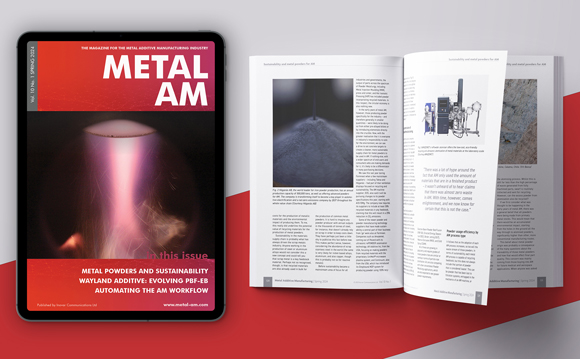AddUp produces liquid rocket engine by Additive Manufacturing
July 7, 2019

The Aurora Liquid Engine was developed by Estaca Space Odyssey and produced on AddUp’s FormUp 350 metal Additive Manufacturing machine (Courtesy AddUp)
AddUp, Clermont-Ferrand, France, has used its metal Additive Manufacturing system to produce a rocket engine in Inconel 718, in support of the final year project of a group of students at France’s School of Engineers Specialising in Aeronautic, Rail and Space Travel (ESTACA). The project, titled Aurora Liquid Engine, aimed to demonstrate that it is possible to build an extremely low-cost, high-performance engine in only six months.
The Aurora Liquid Engine is said to be the first oxygen/kerosene liquid rocket engine developed by Estaca Space Odyssey (ESO); operated using a static launch pad, it is designed to deliver a 100 kg propulsion for thirty seconds. The engine was produced using Laser Powder Bed Fusion (L-PBF) on an AddUp FormUp 350 metal AM system, and was said to have been produced in a single piece without support materials.
The goal of the Aurora Liquid Engine project is to complete all stages of development of a liquid rocket engine, from preliminary studies and scaling through to the manufacture of a launch pad and engine parts. This experience is expected to enable the students to strengthen their practical and experimental skills while tackling a range of engineering issues, including fluid, topology and heat optimisation.
As an experiment, the project offers its participants the opportunity to complete small-scale testing of new solutions for the liquid rocket propulsion sector: a metal additively manufactured combustion chamber and pipe, the choice of triple injection, and a geometrically optimised cooling channel.
The engine has a ‘regenerative cooling system’ that channels heat from combustion through the engine wall and transfers it into the fuel that travels through the ducts within the body of the chamber. While cooling the chamber, the mixture is reheated before being ignited within the combustion chamber.
The project will reportedly end with a static launch test at ArianeGroup’s Vernon site, where Ariane 6’s Vinci and Vulcain 2.1 engines are built and tested. Testing will also include the collection and analysis of the engine’s performance data over thirty seconds, which broadly corresponds to the length of time taken for a rocket to enter the stratosphere.
















